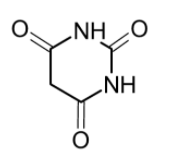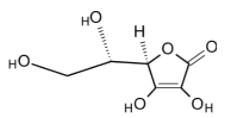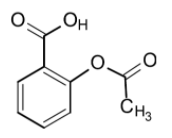
The carboxyl functional group (—COOH) is present in:
A) Picric acid
B) Barbituric acid
C) Ascorbic acid
D) Aspirin
Answer
476.1k+ views
Hint: A carboxylic acid is a functional group in which the carbon atoms bonded to the oxygen atom by a double bond. The hydroxyl group $\text{-OH}$ is bounded by a single bond. The fourth bond is bonded to the alkyl or the aryl group. However, some compounds contain the acidic proton which is bonded to oxygen or nitrogen can act as an acid too.
Complete step by step solution:
A carboxylic acid is an organic compound that has a carboxyl group $\text{(-COOH)}$ that is attached to the R-group. The R can be alkyl or aryl. The general formula is $\text{(R-COOH)}$.
Let us have a look at each option to get the answer:
Picric acid is a derivative of phenol. Phenol is a weak acid due to the presence of the hydroxyl group on it. Which dissociates to form ${{\text{H}}^{\text{+}}}$ ions in the solution. The picric acid which is a trinitro derivative of phenol has high acidic strength. The structure is as shown below,

It does not contain the carboxylic acid $\text{(-COOH)}$ group in it. Thus picric acid is not a carboxylic acid.
Hence, option (A) cannot be true.
Barbituric acid is acid. It has a pyrimidine heterocyclic structure. It contains the carbonyl group and the $\text{-NH}$ group. Therefore the $\text{ }\!\!\alpha\!\!\text{ -Carbon}$ have the reactive hydrogen atoms which are acidic. These protons on the amino groups give the acidic strength to the barbituric acid. Since I do not contain the carboxylic acid $\text{(-COOH)}$ group, the option (B) cannot be true.

Ascorbic acid is also found to be acidic. It vigorously generates the ascorbate anion in the solution when one of the hydroxyl groups get deprotonated. The structure of ascorbic acid is as shown below,

It exhibits the acidic properties due to the presence of acidic protons on the hydroxyl group. But it does not have a carboxylic acid group $\text{(-COOH)}$.hence the ascorbic acid cannot be treated as the carboxylic acid and thus, option (C) cannot be true.
The aspirin is also called as the acetylsalicylic acid or 2-acetoxybenzoic acid. It is a salicylic acid derivative where the hydroxyl group of salicylic acid undergoes the acetylation. It contains three groups:
1) Carboxylic acid functional group (R-COOH)
2) Ester functional group (R-O-CO-R')
3) Aromatic group (benzene ring)

The acidity of the aspirin arises due to the loss of a proton. It is a weak acid.
It contains the carboxylic acid group.
Hence, the option (D) is the correct option.
Note: The acidity can arise due to the acidic proton which can be bonded to the electronegative atom. For example, the phenols are acidic since the hydrogen is bonded to the oxygen which withdraws the electron density. The amino group can also donate its proton.
Complete step by step solution:
A carboxylic acid is an organic compound that has a carboxyl group $\text{(-COOH)}$ that is attached to the R-group. The R can be alkyl or aryl. The general formula is $\text{(R-COOH)}$.
Let us have a look at each option to get the answer:
Picric acid is a derivative of phenol. Phenol is a weak acid due to the presence of the hydroxyl group on it. Which dissociates to form ${{\text{H}}^{\text{+}}}$ ions in the solution. The picric acid which is a trinitro derivative of phenol has high acidic strength. The structure is as shown below,

It does not contain the carboxylic acid $\text{(-COOH)}$ group in it. Thus picric acid is not a carboxylic acid.
Hence, option (A) cannot be true.
Barbituric acid is acid. It has a pyrimidine heterocyclic structure. It contains the carbonyl group and the $\text{-NH}$ group. Therefore the $\text{ }\!\!\alpha\!\!\text{ -Carbon}$ have the reactive hydrogen atoms which are acidic. These protons on the amino groups give the acidic strength to the barbituric acid. Since I do not contain the carboxylic acid $\text{(-COOH)}$ group, the option (B) cannot be true.

Ascorbic acid is also found to be acidic. It vigorously generates the ascorbate anion in the solution when one of the hydroxyl groups get deprotonated. The structure of ascorbic acid is as shown below,

It exhibits the acidic properties due to the presence of acidic protons on the hydroxyl group. But it does not have a carboxylic acid group $\text{(-COOH)}$.hence the ascorbic acid cannot be treated as the carboxylic acid and thus, option (C) cannot be true.
The aspirin is also called as the acetylsalicylic acid or 2-acetoxybenzoic acid. It is a salicylic acid derivative where the hydroxyl group of salicylic acid undergoes the acetylation. It contains three groups:
1) Carboxylic acid functional group (R-COOH)
2) Ester functional group (R-O-CO-R')
3) Aromatic group (benzene ring)

The acidity of the aspirin arises due to the loss of a proton. It is a weak acid.
It contains the carboxylic acid group.
Hence, the option (D) is the correct option.
Note: The acidity can arise due to the acidic proton which can be bonded to the electronegative atom. For example, the phenols are acidic since the hydrogen is bonded to the oxygen which withdraws the electron density. The amino group can also donate its proton.
Recently Updated Pages
Using the following information to help you answer class 12 chemistry CBSE

Full Form of IASDMIPSIFSIRSPOLICE class 7 social science CBSE

In case of conflict between fundamental rights of citizens class 7 social science CBSE

Can anyone list 10 advantages and disadvantages of friction

What are the Components of Financial System?

Complete the letter given below written to your Principal class null english null

Trending doubts
Show variation of resistivity of copper as a function class 12 physics CBSE

Electrolysis of dilute H2SO4 generates H2S2O8 What class 12 chemistry CBSE

Explain with a neat labelled diagram the TS of mammalian class 12 biology CBSE

How do you convert from joules to electron volts class 12 physics CBSE

A convex lens is placed in water Its focal length A class 12 physics CBSE

Distinguish between asexual and sexual reproduction class 12 biology CBSE




